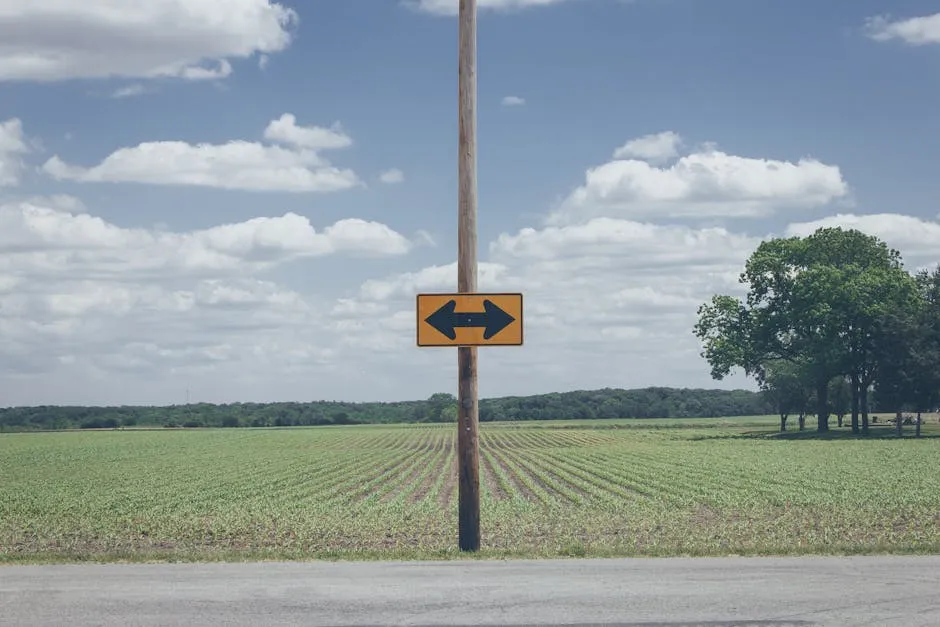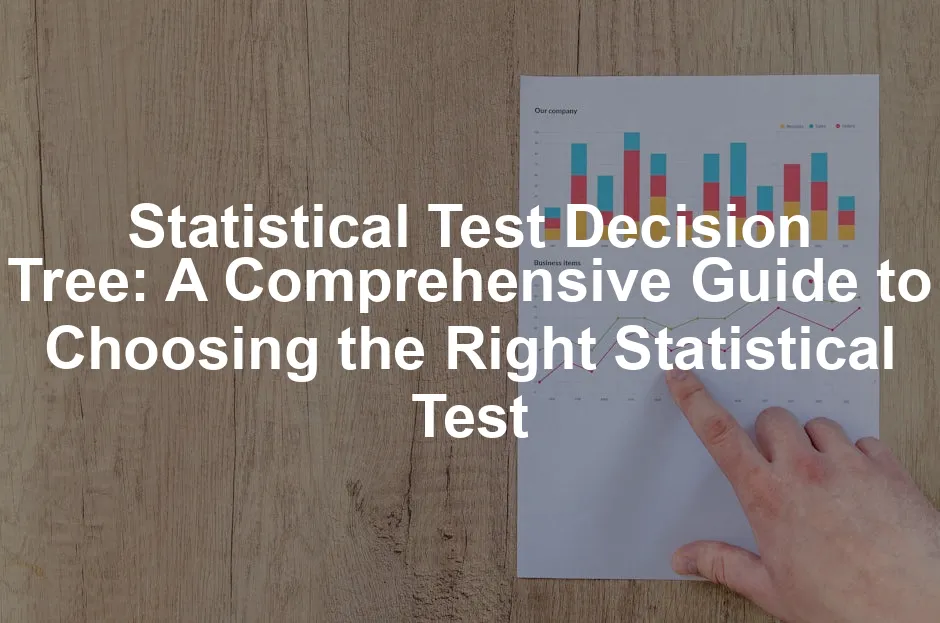Example Questions for Each Node:
- What is my research question?
- Define the focus of your study.
- What type of data do I have?
- Categorical or continuous?
- How many groups am I comparing?
- Two groups or more than two?
- Which statistical test fits my scenario?
- T-test, ANOVA, Chi-square, etc.
- Do I meet the assumptions for my chosen test?
- Normality, homogeneity of variance, etc.
By following these steps, you’ll create a personalized decision tree that simplifies the testing process. Remember, a well-structured decision tree not only boosts your confidence but also enhances the accuracy of your research conclusions. Happy testing!

Tools and Resources
Creating a decision tree doesn’t have to be a daunting task. Several online tools can help you craft interactive flowcharts that simplify the process of choosing the right statistical test. Here are some recommended resources:
- Statistics4U Wizard: This user-friendly tool guides you through a series of questions to help you select the appropriate statistical test based on your data. Check it out here.
- StatsFlowchart: An interactive decision tree designed by Matt Jackson-Wood, this flowchart helps you determine which statistical test to use. It’s based on research by Andy Field. Explore this resource here.
- Insilicase: This platform includes a decision tree for selecting appropriate statistical tests, tailored to various data analysis needs. Dive into their offerings here.
For further learning, consider these reputable online courses and articles:
- Statistical Tests Guide: A comprehensive overview of different statistical tests and their applications can be found on Sage Research Methods.
- Decision Trees in Data Science: For a deeper understanding of decision trees, consult the article on Wikipedia.

Real-World Applications of Statistical Test Decision Trees
Case Studies
Case Study 1: Dietary Intervention Study
In a recent study examining the effects of a new dietary intervention on weight loss, researchers utilized a decision tree to select the appropriate statistical test. Initially, they identified their data as continuous (weight loss in kilograms) and divided participants into two groups: one receiving the diet and one following their usual eating habits. The decision tree led them to use an independent t-test to compare the means of the two groups. The results indicated a statistically significant weight loss in the intervention group, validating the effectiveness of the diet. This case highlighted the decision tree’s role in guiding researchers to the correct test, avoiding potential pitfalls associated with incorrect test selection.

Case Study 2: Survey Data Analysis
Another example involved researchers analyzing survey data on customer satisfaction. The data collected were ordinal, with responses ranging from “very dissatisfied” to “very satisfied.” The decision tree helped them recognize they were dealing with more than two groups and that the data did not meet the assumptions for parametric tests. Consequently, they opted for a Kruskal-Wallis test, a non-parametric alternative. This choice not only provided accurate insights into customer satisfaction levels but also emphasized the importance of using the right statistical test based on data type.

Case Study 3: Clinical Trial of a New Drug
In a clinical trial assessing a new drug’s effectiveness, researchers faced a complex dataset involving multiple groups and various measurements. They employed a decision tree to navigate through their options. By defining their data as categorical (treatment vs. control) and continuous (response scores), they were directed to use ANOVA to compare means across the treatment groups. The outcome revealed significant differences in response scores, demonstrating the decision tree’s effectiveness in simplifying the test selection process amidst complexity.
These case studies illustrate the practical application of statistical test decision trees in diverse research settings. They not only streamline the decision-making process but also ensure that researchers select appropriate tests, leading to valid and reliable results.

Conclusion
Selecting the right statistical test is crucial for any research endeavor. The implications of using an incorrect test can lead to misguided conclusions and affect the overall credibility of the research. Decision trees serve as invaluable tools to simplify this selection process, guiding researchers step-by-step toward the best test for their data. For a comprehensive guide on statistical tests, check out this flow chart for statistical tests.
Utilizing decision trees can greatly enhance the accuracy of your analyses. Learn more about the differences between practical significance versus statistical significance to improve your research quality.
By utilizing decision trees, you can enhance the accuracy of your analyses and improve the quality of your findings. Whether you’re tackling a dietary study or analyzing survey responses, these trees provide clarity and confidence in your statistical choices. So, go ahead! Embrace decision trees in your statistical analysis journey. They may just be the trusty compass you need to navigate the world of statistics with ease.
And speaking of navigating, if you’re looking to improve your overall well-being while crunching numbers, check out The Complete Guide to Fasting. It’s an excellent read for anyone interested in healing their body through various fasting methods, giving you the energy to tackle all your statistical challenges!
And while you’re at it, why not consider Atomic Habits? It offers practical strategies for forming good habits and breaking bad ones, perfect for anyone wanting to boost their productivity in research and beyond.
All images from Pexels
Step 6: Document Your Decision Tree
Now that you have determined the path, sketch out your decision tree. It can be a simple flowchart or a fancy diagram. The key is to have a visual representation of your decision-making process.
Example Questions for Each Node:
- What is my research question?
- Define the focus of your study.
- What type of data do I have?
- Categorical or continuous?
- How many groups am I comparing?
- Two groups or more than two?
- Which statistical test fits my scenario?
- T-test, ANOVA, Chi-square, etc.
- Do I meet the assumptions for my chosen test?
- Normality, homogeneity of variance, etc.
By following these steps, you’ll create a personalized decision tree that simplifies the testing process. Remember, a well-structured decision tree not only boosts your confidence but also enhances the accuracy of your research conclusions. Happy testing!

Tools and Resources
Creating a decision tree doesn’t have to be a daunting task. Several online tools can help you craft interactive flowcharts that simplify the process of choosing the right statistical test. Here are some recommended resources:
- Statistics4U Wizard: This user-friendly tool guides you through a series of questions to help you select the appropriate statistical test based on your data. Check it out here.
- StatsFlowchart: An interactive decision tree designed by Matt Jackson-Wood, this flowchart helps you determine which statistical test to use. It’s based on research by Andy Field. Explore this resource here.
- Insilicase: This platform includes a decision tree for selecting appropriate statistical tests, tailored to various data analysis needs. Dive into their offerings here.
For further learning, consider these reputable online courses and articles:
- Statistical Tests Guide: A comprehensive overview of different statistical tests and their applications can be found on Sage Research Methods.
- Decision Trees in Data Science: For a deeper understanding of decision trees, consult the article on Wikipedia.

Real-World Applications of Statistical Test Decision Trees
Case Studies
Case Study 1: Dietary Intervention Study
In a recent study examining the effects of a new dietary intervention on weight loss, researchers utilized a decision tree to select the appropriate statistical test. Initially, they identified their data as continuous (weight loss in kilograms) and divided participants into two groups: one receiving the diet and one following their usual eating habits. The decision tree led them to use an independent t-test to compare the means of the two groups. The results indicated a statistically significant weight loss in the intervention group, validating the effectiveness of the diet. This case highlighted the decision tree’s role in guiding researchers to the correct test, avoiding potential pitfalls associated with incorrect test selection.

Case Study 2: Survey Data Analysis
Another example involved researchers analyzing survey data on customer satisfaction. The data collected were ordinal, with responses ranging from “very dissatisfied” to “very satisfied.” The decision tree helped them recognize they were dealing with more than two groups and that the data did not meet the assumptions for parametric tests. Consequently, they opted for a Kruskal-Wallis test, a non-parametric alternative. This choice not only provided accurate insights into customer satisfaction levels but also emphasized the importance of using the right statistical test based on data type.

Case Study 3: Clinical Trial of a New Drug
In a clinical trial assessing a new drug’s effectiveness, researchers faced a complex dataset involving multiple groups and various measurements. They employed a decision tree to navigate through their options. By defining their data as categorical (treatment vs. control) and continuous (response scores), they were directed to use ANOVA to compare means across the treatment groups. The outcome revealed significant differences in response scores, demonstrating the decision tree’s effectiveness in simplifying the test selection process amidst complexity.
These case studies illustrate the practical application of statistical test decision trees in diverse research settings. They not only streamline the decision-making process but also ensure that researchers select appropriate tests, leading to valid and reliable results.

Conclusion
Selecting the right statistical test is crucial for any research endeavor. The implications of using an incorrect test can lead to misguided conclusions and affect the overall credibility of the research. Decision trees serve as invaluable tools to simplify this selection process, guiding researchers step-by-step toward the best test for their data. For a comprehensive guide on statistical tests, check out this flow chart for statistical tests.
Utilizing decision trees can greatly enhance the accuracy of your analyses. Learn more about the differences between practical significance versus statistical significance to improve your research quality.
By utilizing decision trees, you can enhance the accuracy of your analyses and improve the quality of your findings. Whether you’re tackling a dietary study or analyzing survey responses, these trees provide clarity and confidence in your statistical choices. So, go ahead! Embrace decision trees in your statistical analysis journey. They may just be the trusty compass you need to navigate the world of statistics with ease.
And speaking of navigating, if you’re looking to improve your overall well-being while crunching numbers, check out The Complete Guide to Fasting. It’s an excellent read for anyone interested in healing their body through various fasting methods, giving you the energy to tackle all your statistical challenges!
And while you’re at it, why not consider Atomic Habits? It offers practical strategies for forming good habits and breaking bad ones, perfect for anyone wanting to boost their productivity in research and beyond.
All images from Pexels
Step 5: Check Assumptions
Most statistical tests come with assumptions. It’s like going to a party—sometimes, there are dress codes! Check if your data meets these assumptions. Ask yourself: “Does my data meet the normality and variance assumptions required for this test?”
Step 6: Document Your Decision Tree
Now that you have determined the path, sketch out your decision tree. It can be a simple flowchart or a fancy diagram. The key is to have a visual representation of your decision-making process.
Example Questions for Each Node:
- What is my research question?
- Define the focus of your study.
- What type of data do I have?
- Categorical or continuous?
- How many groups am I comparing?
- Two groups or more than two?
- Which statistical test fits my scenario?
- T-test, ANOVA, Chi-square, etc.
- Do I meet the assumptions for my chosen test?
- Normality, homogeneity of variance, etc.
By following these steps, you’ll create a personalized decision tree that simplifies the testing process. Remember, a well-structured decision tree not only boosts your confidence but also enhances the accuracy of your research conclusions. Happy testing!

Tools and Resources
Creating a decision tree doesn’t have to be a daunting task. Several online tools can help you craft interactive flowcharts that simplify the process of choosing the right statistical test. Here are some recommended resources:
- Statistics4U Wizard: This user-friendly tool guides you through a series of questions to help you select the appropriate statistical test based on your data. Check it out here.
- StatsFlowchart: An interactive decision tree designed by Matt Jackson-Wood, this flowchart helps you determine which statistical test to use. It’s based on research by Andy Field. Explore this resource here.
- Insilicase: This platform includes a decision tree for selecting appropriate statistical tests, tailored to various data analysis needs. Dive into their offerings here.
For further learning, consider these reputable online courses and articles:
- Statistical Tests Guide: A comprehensive overview of different statistical tests and their applications can be found on Sage Research Methods.
- Decision Trees in Data Science: For a deeper understanding of decision trees, consult the article on Wikipedia.

Real-World Applications of Statistical Test Decision Trees
Case Studies
Case Study 1: Dietary Intervention Study
In a recent study examining the effects of a new dietary intervention on weight loss, researchers utilized a decision tree to select the appropriate statistical test. Initially, they identified their data as continuous (weight loss in kilograms) and divided participants into two groups: one receiving the diet and one following their usual eating habits. The decision tree led them to use an independent t-test to compare the means of the two groups. The results indicated a statistically significant weight loss in the intervention group, validating the effectiveness of the diet. This case highlighted the decision tree’s role in guiding researchers to the correct test, avoiding potential pitfalls associated with incorrect test selection.

Case Study 2: Survey Data Analysis
Another example involved researchers analyzing survey data on customer satisfaction. The data collected were ordinal, with responses ranging from “very dissatisfied” to “very satisfied.” The decision tree helped them recognize they were dealing with more than two groups and that the data did not meet the assumptions for parametric tests. Consequently, they opted for a Kruskal-Wallis test, a non-parametric alternative. This choice not only provided accurate insights into customer satisfaction levels but also emphasized the importance of using the right statistical test based on data type.

Case Study 3: Clinical Trial of a New Drug
In a clinical trial assessing a new drug’s effectiveness, researchers faced a complex dataset involving multiple groups and various measurements. They employed a decision tree to navigate through their options. By defining their data as categorical (treatment vs. control) and continuous (response scores), they were directed to use ANOVA to compare means across the treatment groups. The outcome revealed significant differences in response scores, demonstrating the decision tree’s effectiveness in simplifying the test selection process amidst complexity.
These case studies illustrate the practical application of statistical test decision trees in diverse research settings. They not only streamline the decision-making process but also ensure that researchers select appropriate tests, leading to valid and reliable results.

Conclusion
Selecting the right statistical test is crucial for any research endeavor. The implications of using an incorrect test can lead to misguided conclusions and affect the overall credibility of the research. Decision trees serve as invaluable tools to simplify this selection process, guiding researchers step-by-step toward the best test for their data. For a comprehensive guide on statistical tests, check out this flow chart for statistical tests.
Utilizing decision trees can greatly enhance the accuracy of your analyses. Learn more about the differences between practical significance versus statistical significance to improve your research quality.
By utilizing decision trees, you can enhance the accuracy of your analyses and improve the quality of your findings. Whether you’re tackling a dietary study or analyzing survey responses, these trees provide clarity and confidence in your statistical choices. So, go ahead! Embrace decision trees in your statistical analysis journey. They may just be the trusty compass you need to navigate the world of statistics with ease.
And speaking of navigating, if you’re looking to improve your overall well-being while crunching numbers, check out The Complete Guide to Fasting. It’s an excellent read for anyone interested in healing their body through various fasting methods, giving you the energy to tackle all your statistical challenges!
And while you’re at it, why not consider Atomic Habits? It offers practical strategies for forming good habits and breaking bad ones, perfect for anyone wanting to boost their productivity in research and beyond.
All images from Pexels
Step 4: Choose the Appropriate Statistical Test
Based on your previous answers, you can now select the appropriate test. For instance, if you’re comparing two groups with continuous data, the t-test is your go-to. If you’re looking at more than two groups, ANOVA is the way to go.
Step 5: Check Assumptions
Most statistical tests come with assumptions. It’s like going to a party—sometimes, there are dress codes! Check if your data meets these assumptions. Ask yourself: “Does my data meet the normality and variance assumptions required for this test?”
Step 6: Document Your Decision Tree
Now that you have determined the path, sketch out your decision tree. It can be a simple flowchart or a fancy diagram. The key is to have a visual representation of your decision-making process.
Example Questions for Each Node:
- What is my research question?
- Define the focus of your study.
- What type of data do I have?
- Categorical or continuous?
- How many groups am I comparing?
- Two groups or more than two?
- Which statistical test fits my scenario?
- T-test, ANOVA, Chi-square, etc.
- Do I meet the assumptions for my chosen test?
- Normality, homogeneity of variance, etc.
By following these steps, you’ll create a personalized decision tree that simplifies the testing process. Remember, a well-structured decision tree not only boosts your confidence but also enhances the accuracy of your research conclusions. Happy testing!

Tools and Resources
Creating a decision tree doesn’t have to be a daunting task. Several online tools can help you craft interactive flowcharts that simplify the process of choosing the right statistical test. Here are some recommended resources:
- Statistics4U Wizard: This user-friendly tool guides you through a series of questions to help you select the appropriate statistical test based on your data. Check it out here.
- StatsFlowchart: An interactive decision tree designed by Matt Jackson-Wood, this flowchart helps you determine which statistical test to use. It’s based on research by Andy Field. Explore this resource here.
- Insilicase: This platform includes a decision tree for selecting appropriate statistical tests, tailored to various data analysis needs. Dive into their offerings here.
For further learning, consider these reputable online courses and articles:
- Statistical Tests Guide: A comprehensive overview of different statistical tests and their applications can be found on Sage Research Methods.
- Decision Trees in Data Science: For a deeper understanding of decision trees, consult the article on Wikipedia.

Real-World Applications of Statistical Test Decision Trees
Case Studies
Case Study 1: Dietary Intervention Study
In a recent study examining the effects of a new dietary intervention on weight loss, researchers utilized a decision tree to select the appropriate statistical test. Initially, they identified their data as continuous (weight loss in kilograms) and divided participants into two groups: one receiving the diet and one following their usual eating habits. The decision tree led them to use an independent t-test to compare the means of the two groups. The results indicated a statistically significant weight loss in the intervention group, validating the effectiveness of the diet. This case highlighted the decision tree’s role in guiding researchers to the correct test, avoiding potential pitfalls associated with incorrect test selection.

Case Study 2: Survey Data Analysis
Another example involved researchers analyzing survey data on customer satisfaction. The data collected were ordinal, with responses ranging from “very dissatisfied” to “very satisfied.” The decision tree helped them recognize they were dealing with more than two groups and that the data did not meet the assumptions for parametric tests. Consequently, they opted for a Kruskal-Wallis test, a non-parametric alternative. This choice not only provided accurate insights into customer satisfaction levels but also emphasized the importance of using the right statistical test based on data type.

Case Study 3: Clinical Trial of a New Drug
In a clinical trial assessing a new drug’s effectiveness, researchers faced a complex dataset involving multiple groups and various measurements. They employed a decision tree to navigate through their options. By defining their data as categorical (treatment vs. control) and continuous (response scores), they were directed to use ANOVA to compare means across the treatment groups. The outcome revealed significant differences in response scores, demonstrating the decision tree’s effectiveness in simplifying the test selection process amidst complexity.
These case studies illustrate the practical application of statistical test decision trees in diverse research settings. They not only streamline the decision-making process but also ensure that researchers select appropriate tests, leading to valid and reliable results.

Conclusion
Selecting the right statistical test is crucial for any research endeavor. The implications of using an incorrect test can lead to misguided conclusions and affect the overall credibility of the research. Decision trees serve as invaluable tools to simplify this selection process, guiding researchers step-by-step toward the best test for their data. For a comprehensive guide on statistical tests, check out this flow chart for statistical tests.
Utilizing decision trees can greatly enhance the accuracy of your analyses. Learn more about the differences between practical significance versus statistical significance to improve your research quality.
By utilizing decision trees, you can enhance the accuracy of your analyses and improve the quality of your findings. Whether you’re tackling a dietary study or analyzing survey responses, these trees provide clarity and confidence in your statistical choices. So, go ahead! Embrace decision trees in your statistical analysis journey. They may just be the trusty compass you need to navigate the world of statistics with ease.
And speaking of navigating, if you’re looking to improve your overall well-being while crunching numbers, check out The Complete Guide to Fasting. It’s an excellent read for anyone interested in healing their body through various fasting methods, giving you the energy to tackle all your statistical challenges!
And while you’re at it, why not consider Atomic Habits? It offers practical strategies for forming good habits and breaking bad ones, perfect for anyone wanting to boost their productivity in research and beyond.
All images from Pexels
Step 3: Establish the Number of Groups
Now, consider how many groups you’re comparing. Are you examining two groups or more than two? A question here might be: “Am I comparing just two groups or three or more?” This will help you narrow down the tests available.
Step 4: Choose the Appropriate Statistical Test
Based on your previous answers, you can now select the appropriate test. For instance, if you’re comparing two groups with continuous data, the t-test is your go-to. If you’re looking at more than two groups, ANOVA is the way to go.
Step 5: Check Assumptions
Most statistical tests come with assumptions. It’s like going to a party—sometimes, there are dress codes! Check if your data meets these assumptions. Ask yourself: “Does my data meet the normality and variance assumptions required for this test?”
Step 6: Document Your Decision Tree
Now that you have determined the path, sketch out your decision tree. It can be a simple flowchart or a fancy diagram. The key is to have a visual representation of your decision-making process.
Example Questions for Each Node:
- What is my research question?
- Define the focus of your study.
- What type of data do I have?
- Categorical or continuous?
- How many groups am I comparing?
- Two groups or more than two?
- Which statistical test fits my scenario?
- T-test, ANOVA, Chi-square, etc.
- Do I meet the assumptions for my chosen test?
- Normality, homogeneity of variance, etc.
By following these steps, you’ll create a personalized decision tree that simplifies the testing process. Remember, a well-structured decision tree not only boosts your confidence but also enhances the accuracy of your research conclusions. Happy testing!

Tools and Resources
Creating a decision tree doesn’t have to be a daunting task. Several online tools can help you craft interactive flowcharts that simplify the process of choosing the right statistical test. Here are some recommended resources:
- Statistics4U Wizard: This user-friendly tool guides you through a series of questions to help you select the appropriate statistical test based on your data. Check it out here.
- StatsFlowchart: An interactive decision tree designed by Matt Jackson-Wood, this flowchart helps you determine which statistical test to use. It’s based on research by Andy Field. Explore this resource here.
- Insilicase: This platform includes a decision tree for selecting appropriate statistical tests, tailored to various data analysis needs. Dive into their offerings here.
For further learning, consider these reputable online courses and articles:
- Statistical Tests Guide: A comprehensive overview of different statistical tests and their applications can be found on Sage Research Methods.
- Decision Trees in Data Science: For a deeper understanding of decision trees, consult the article on Wikipedia.

Real-World Applications of Statistical Test Decision Trees
Case Studies
Case Study 1: Dietary Intervention Study
In a recent study examining the effects of a new dietary intervention on weight loss, researchers utilized a decision tree to select the appropriate statistical test. Initially, they identified their data as continuous (weight loss in kilograms) and divided participants into two groups: one receiving the diet and one following their usual eating habits. The decision tree led them to use an independent t-test to compare the means of the two groups. The results indicated a statistically significant weight loss in the intervention group, validating the effectiveness of the diet. This case highlighted the decision tree’s role in guiding researchers to the correct test, avoiding potential pitfalls associated with incorrect test selection.

Case Study 2: Survey Data Analysis
Another example involved researchers analyzing survey data on customer satisfaction. The data collected were ordinal, with responses ranging from “very dissatisfied” to “very satisfied.” The decision tree helped them recognize they were dealing with more than two groups and that the data did not meet the assumptions for parametric tests. Consequently, they opted for a Kruskal-Wallis test, a non-parametric alternative. This choice not only provided accurate insights into customer satisfaction levels but also emphasized the importance of using the right statistical test based on data type.

Case Study 3: Clinical Trial of a New Drug
In a clinical trial assessing a new drug’s effectiveness, researchers faced a complex dataset involving multiple groups and various measurements. They employed a decision tree to navigate through their options. By defining their data as categorical (treatment vs. control) and continuous (response scores), they were directed to use ANOVA to compare means across the treatment groups. The outcome revealed significant differences in response scores, demonstrating the decision tree’s effectiveness in simplifying the test selection process amidst complexity.
These case studies illustrate the practical application of statistical test decision trees in diverse research settings. They not only streamline the decision-making process but also ensure that researchers select appropriate tests, leading to valid and reliable results.

Conclusion
Selecting the right statistical test is crucial for any research endeavor. The implications of using an incorrect test can lead to misguided conclusions and affect the overall credibility of the research. Decision trees serve as invaluable tools to simplify this selection process, guiding researchers step-by-step toward the best test for their data. For a comprehensive guide on statistical tests, check out this flow chart for statistical tests.
Utilizing decision trees can greatly enhance the accuracy of your analyses. Learn more about the differences between practical significance versus statistical significance to improve your research quality.
By utilizing decision trees, you can enhance the accuracy of your analyses and improve the quality of your findings. Whether you’re tackling a dietary study or analyzing survey responses, these trees provide clarity and confidence in your statistical choices. So, go ahead! Embrace decision trees in your statistical analysis journey. They may just be the trusty compass you need to navigate the world of statistics with ease.
And speaking of navigating, if you’re looking to improve your overall well-being while crunching numbers, check out The Complete Guide to Fasting. It’s an excellent read for anyone interested in healing their body through various fasting methods, giving you the energy to tackle all your statistical challenges!
And while you’re at it, why not consider Atomic Habits? It offers practical strategies for forming good habits and breaking bad ones, perfect for anyone wanting to boost their productivity in research and beyond.
All images from Pexels
Step 2: Identify Your Data Type
Next, determine the type of data you have. Is it categorical (like gender) or continuous (like weight)? This is crucial! A simple question to ask could be: “Is my data numerical or categorical?” Your answer will guide the next step.
Step 3: Establish the Number of Groups
Now, consider how many groups you’re comparing. Are you examining two groups or more than two? A question here might be: “Am I comparing just two groups or three or more?” This will help you narrow down the tests available.
Step 4: Choose the Appropriate Statistical Test
Based on your previous answers, you can now select the appropriate test. For instance, if you’re comparing two groups with continuous data, the t-test is your go-to. If you’re looking at more than two groups, ANOVA is the way to go.
Step 5: Check Assumptions
Most statistical tests come with assumptions. It’s like going to a party—sometimes, there are dress codes! Check if your data meets these assumptions. Ask yourself: “Does my data meet the normality and variance assumptions required for this test?”
Step 6: Document Your Decision Tree
Now that you have determined the path, sketch out your decision tree. It can be a simple flowchart or a fancy diagram. The key is to have a visual representation of your decision-making process.
Example Questions for Each Node:
- What is my research question?
- Define the focus of your study.
- What type of data do I have?
- Categorical or continuous?
- How many groups am I comparing?
- Two groups or more than two?
- Which statistical test fits my scenario?
- T-test, ANOVA, Chi-square, etc.
- Do I meet the assumptions for my chosen test?
- Normality, homogeneity of variance, etc.
By following these steps, you’ll create a personalized decision tree that simplifies the testing process. Remember, a well-structured decision tree not only boosts your confidence but also enhances the accuracy of your research conclusions. Happy testing!

Tools and Resources
Creating a decision tree doesn’t have to be a daunting task. Several online tools can help you craft interactive flowcharts that simplify the process of choosing the right statistical test. Here are some recommended resources:
- Statistics4U Wizard: This user-friendly tool guides you through a series of questions to help you select the appropriate statistical test based on your data. Check it out here.
- StatsFlowchart: An interactive decision tree designed by Matt Jackson-Wood, this flowchart helps you determine which statistical test to use. It’s based on research by Andy Field. Explore this resource here.
- Insilicase: This platform includes a decision tree for selecting appropriate statistical tests, tailored to various data analysis needs. Dive into their offerings here.
For further learning, consider these reputable online courses and articles:
- Statistical Tests Guide: A comprehensive overview of different statistical tests and their applications can be found on Sage Research Methods.
- Decision Trees in Data Science: For a deeper understanding of decision trees, consult the article on Wikipedia.

Real-World Applications of Statistical Test Decision Trees
Case Studies
Case Study 1: Dietary Intervention Study
In a recent study examining the effects of a new dietary intervention on weight loss, researchers utilized a decision tree to select the appropriate statistical test. Initially, they identified their data as continuous (weight loss in kilograms) and divided participants into two groups: one receiving the diet and one following their usual eating habits. The decision tree led them to use an independent t-test to compare the means of the two groups. The results indicated a statistically significant weight loss in the intervention group, validating the effectiveness of the diet. This case highlighted the decision tree’s role in guiding researchers to the correct test, avoiding potential pitfalls associated with incorrect test selection.

Case Study 2: Survey Data Analysis
Another example involved researchers analyzing survey data on customer satisfaction. The data collected were ordinal, with responses ranging from “very dissatisfied” to “very satisfied.” The decision tree helped them recognize they were dealing with more than two groups and that the data did not meet the assumptions for parametric tests. Consequently, they opted for a Kruskal-Wallis test, a non-parametric alternative. This choice not only provided accurate insights into customer satisfaction levels but also emphasized the importance of using the right statistical test based on data type.

Case Study 3: Clinical Trial of a New Drug
In a clinical trial assessing a new drug’s effectiveness, researchers faced a complex dataset involving multiple groups and various measurements. They employed a decision tree to navigate through their options. By defining their data as categorical (treatment vs. control) and continuous (response scores), they were directed to use ANOVA to compare means across the treatment groups. The outcome revealed significant differences in response scores, demonstrating the decision tree’s effectiveness in simplifying the test selection process amidst complexity.
These case studies illustrate the practical application of statistical test decision trees in diverse research settings. They not only streamline the decision-making process but also ensure that researchers select appropriate tests, leading to valid and reliable results.

Conclusion
Selecting the right statistical test is crucial for any research endeavor. The implications of using an incorrect test can lead to misguided conclusions and affect the overall credibility of the research. Decision trees serve as invaluable tools to simplify this selection process, guiding researchers step-by-step toward the best test for their data. For a comprehensive guide on statistical tests, check out this flow chart for statistical tests.
Utilizing decision trees can greatly enhance the accuracy of your analyses. Learn more about the differences between practical significance versus statistical significance to improve your research quality.
By utilizing decision trees, you can enhance the accuracy of your analyses and improve the quality of your findings. Whether you’re tackling a dietary study or analyzing survey responses, these trees provide clarity and confidence in your statistical choices. So, go ahead! Embrace decision trees in your statistical analysis journey. They may just be the trusty compass you need to navigate the world of statistics with ease.
And speaking of navigating, if you’re looking to improve your overall well-being while crunching numbers, check out The Complete Guide to Fasting. It’s an excellent read for anyone interested in healing their body through various fasting methods, giving you the energy to tackle all your statistical challenges!
And while you’re at it, why not consider Atomic Habits? It offers practical strategies for forming good habits and breaking bad ones, perfect for anyone wanting to boost their productivity in research and beyond.
All images from Pexels
Step 1: Define Your Research Question
Start by clarifying your research question. Ask yourself: What am I trying to find out? For example, are you looking to compare the effectiveness of two different diets on weight loss? This is your foundation.
Step 2: Identify Your Data Type
Next, determine the type of data you have. Is it categorical (like gender) or continuous (like weight)? This is crucial! A simple question to ask could be: “Is my data numerical or categorical?” Your answer will guide the next step.
Step 3: Establish the Number of Groups
Now, consider how many groups you’re comparing. Are you examining two groups or more than two? A question here might be: “Am I comparing just two groups or three or more?” This will help you narrow down the tests available.
Step 4: Choose the Appropriate Statistical Test
Based on your previous answers, you can now select the appropriate test. For instance, if you’re comparing two groups with continuous data, the t-test is your go-to. If you’re looking at more than two groups, ANOVA is the way to go.
Step 5: Check Assumptions
Most statistical tests come with assumptions. It’s like going to a party—sometimes, there are dress codes! Check if your data meets these assumptions. Ask yourself: “Does my data meet the normality and variance assumptions required for this test?”
Step 6: Document Your Decision Tree
Now that you have determined the path, sketch out your decision tree. It can be a simple flowchart or a fancy diagram. The key is to have a visual representation of your decision-making process.
Example Questions for Each Node:
- What is my research question?
- Define the focus of your study.
- What type of data do I have?
- Categorical or continuous?
- How many groups am I comparing?
- Two groups or more than two?
- Which statistical test fits my scenario?
- T-test, ANOVA, Chi-square, etc.
- Do I meet the assumptions for my chosen test?
- Normality, homogeneity of variance, etc.
By following these steps, you’ll create a personalized decision tree that simplifies the testing process. Remember, a well-structured decision tree not only boosts your confidence but also enhances the accuracy of your research conclusions. Happy testing!

Tools and Resources
Creating a decision tree doesn’t have to be a daunting task. Several online tools can help you craft interactive flowcharts that simplify the process of choosing the right statistical test. Here are some recommended resources:
- Statistics4U Wizard: This user-friendly tool guides you through a series of questions to help you select the appropriate statistical test based on your data. Check it out here.
- StatsFlowchart: An interactive decision tree designed by Matt Jackson-Wood, this flowchart helps you determine which statistical test to use. It’s based on research by Andy Field. Explore this resource here.
- Insilicase: This platform includes a decision tree for selecting appropriate statistical tests, tailored to various data analysis needs. Dive into their offerings here.
For further learning, consider these reputable online courses and articles:
- Statistical Tests Guide: A comprehensive overview of different statistical tests and their applications can be found on Sage Research Methods.
- Decision Trees in Data Science: For a deeper understanding of decision trees, consult the article on Wikipedia.

Real-World Applications of Statistical Test Decision Trees
Case Studies
Case Study 1: Dietary Intervention Study
In a recent study examining the effects of a new dietary intervention on weight loss, researchers utilized a decision tree to select the appropriate statistical test. Initially, they identified their data as continuous (weight loss in kilograms) and divided participants into two groups: one receiving the diet and one following their usual eating habits. The decision tree led them to use an independent t-test to compare the means of the two groups. The results indicated a statistically significant weight loss in the intervention group, validating the effectiveness of the diet. This case highlighted the decision tree’s role in guiding researchers to the correct test, avoiding potential pitfalls associated with incorrect test selection.

Case Study 2: Survey Data Analysis
Another example involved researchers analyzing survey data on customer satisfaction. The data collected were ordinal, with responses ranging from “very dissatisfied” to “very satisfied.” The decision tree helped them recognize they were dealing with more than two groups and that the data did not meet the assumptions for parametric tests. Consequently, they opted for a Kruskal-Wallis test, a non-parametric alternative. This choice not only provided accurate insights into customer satisfaction levels but also emphasized the importance of using the right statistical test based on data type.

Case Study 3: Clinical Trial of a New Drug
In a clinical trial assessing a new drug’s effectiveness, researchers faced a complex dataset involving multiple groups and various measurements. They employed a decision tree to navigate through their options. By defining their data as categorical (treatment vs. control) and continuous (response scores), they were directed to use ANOVA to compare means across the treatment groups. The outcome revealed significant differences in response scores, demonstrating the decision tree’s effectiveness in simplifying the test selection process amidst complexity.
These case studies illustrate the practical application of statistical test decision trees in diverse research settings. They not only streamline the decision-making process but also ensure that researchers select appropriate tests, leading to valid and reliable results.

Conclusion
Selecting the right statistical test is crucial for any research endeavor. The implications of using an incorrect test can lead to misguided conclusions and affect the overall credibility of the research. Decision trees serve as invaluable tools to simplify this selection process, guiding researchers step-by-step toward the best test for their data. For a comprehensive guide on statistical tests, check out this flow chart for statistical tests.
Utilizing decision trees can greatly enhance the accuracy of your analyses. Learn more about the differences between practical significance versus statistical significance to improve your research quality.
By utilizing decision trees, you can enhance the accuracy of your analyses and improve the quality of your findings. Whether you’re tackling a dietary study or analyzing survey responses, these trees provide clarity and confidence in your statistical choices. So, go ahead! Embrace decision trees in your statistical analysis journey. They may just be the trusty compass you need to navigate the world of statistics with ease.
And speaking of navigating, if you’re looking to improve your overall well-being while crunching numbers, check out The Complete Guide to Fasting. It’s an excellent read for anyone interested in healing their body through various fasting methods, giving you the energy to tackle all your statistical challenges!
And while you’re at it, why not consider Atomic Habits? It offers practical strategies for forming good habits and breaking bad ones, perfect for anyone wanting to boost their productivity in research and beyond.
All images from Pexels
Please let us know what you think about our content by leaving a comment down below!
Thank you for reading till here 🙂
Introduction
Statistical tests are the backbone of research. They help us make sense of data and draw conclusions. Imagine trying to uncover the truth hidden in a mountain of numbers without these trusty tools. It would be like trying to find a needle in a haystack—without a magnet!
However, selecting the right statistical test can feel like navigating a maze. With numerous tests available, each suited to different scenarios, it’s easy to feel overwhelmed. Are you comparing means? Testing for relationships? The options seem endless!
Enter the heroic “decision tree.” This nifty tool simplifies the test selection process. Think of it as your friendly GPS for statistical testing. Instead of going in circles, the decision tree leads you step-by-step to the best test for your data.
The purpose of this article is to guide you through the world of statistical test decision trees. By the end, you’ll be equipped to choose the right statistical test with confidence. Let’s turn that statistical fog into a clear, sunny day!

Understanding Statistical Tests
What Are Statistical Tests?
Statistical tests are mathematical methods used to analyze data. They help researchers determine if their findings are significant or if they occurred by chance. Each test has its purpose and specific conditions for use.
Data comes in various types: nominal, ordinal, interval, and ratio. Nominal data categorizes items without a specific order, like colors or names. Ordinal data ranks items but doesn’t define the distance between them, such as a rating scale (1-5 stars). Interval data has defined distances, like temperature in Celsius, but no true zero point. Lastly, ratio data possesses all the features of interval data, plus a true zero, like weight or height.
P-values play a crucial role in hypothesis testing. They represent the probability that the observed differences are due to random chance. A small p-value (typically less than 0.05) suggests a statistically significant result. This means there’s a high likelihood that the observed effect is real and not a coincidence.
Understanding these concepts is vital for selecting the appropriate statistical test. The right test can make all the difference in drawing valid conclusions from your data. So, let’s get ready to dive deeper!

Importance of Choosing the Right Statistical Test
Choosing the right statistical test is crucial. The wrong choice can lead you down a rabbit hole of incorrect conclusions. Imagine testing a drug’s effectiveness only to find you used a test meant for comparing apples to oranges. Spoiler alert: your results will not be valid, and your scientific credibility may take a hit.
Let’s consider a few scenarios. Picture a researcher studying the effect of a new diet on weight loss. If they mistakenly use a t-test when the data doesn’t meet the test’s assumptions, they could declare the diet effective when it isn’t. Oops! In the world of statistics, that’s like claiming you can fly because you jumped off a chair and flapped your arms.
Another example involves analyzing survey data. If a researcher treats ordinal data as continuous, they might incorrectly apply a linear regression when a non-parametric test would be more suitable. This could lead to misleading interpretations and poor decision-making based on those results.
In summary, choosing the right statistical test matters immensely. It’s the difference between solid conclusions and a muddled mess of inaccuracies. Don’t let a simple oversight ruin your research; be informed, and select wisely!

The Concept of a Statistical Test Decision Tree
What is a Decision Tree?
A decision tree is a helpful tool in statistical testing. It’s like a flowchart that guides you through a series of questions to identify the right statistical test for your data.
The structure of a decision tree consists of nodes, branches, and leaves. Nodes represent questions you need to answer about your data. For example, “Is your data categorical or numerical?” Branches illustrate the possible answers. Depending on your response, you’ll follow a different path down the tree. Finally, leaves provide the outcomes, leading you to the most appropriate statistical test.
Decision trees simplify the testing process. They make complex choices feel more manageable, just like choosing a dish at a restaurant with a menu that’s too long.
If you’re serious about mastering data analysis, consider adding Statistical Analysis with Excel For Dummies to your reading list. It’s a fantastic resource for learning how to conduct statistical tests using one of the most popular tools out there.

How Decision Trees Work in Statistical Testing
Decision trees operate by guiding users through a structured series of questions. Each question narrows down the options based on your data’s characteristics, such as type and distribution.
For instance, let’s say you start with a question about your data type. If you answer “categorical,” the tree directs you to another question: “Are you comparing two groups or more than two?” Your answers lead you further down the branches until you reach the final leaf, which identifies the statistical test that fits your scenario.
To visualize this, imagine a flowchart with clear paths based on your responses. At each step, you choose an answer, and the tree branches out, guiding you to the right statistical test. This way, you avoid the confusion of picking a test in the dark.
By following a decision tree, researchers can confidently select the right statistical test, ensuring accurate results and valid conclusions. So, the next time you’re faced with a statistical dilemma, remember: a decision tree is your best friend!

Key Considerations When Choosing a Statistical Test
Selecting the right statistical test can feel like picking the perfect outfit for a first date—so many options, and one wrong choice could lead to awkward situations! To avoid any statistical faux pas, let’s break down the key considerations that will help you choose wisely.
Factors Influencing Test Selection
Study Design
First up, let’s chat about study design. This is the blueprint for your research. Think of it as your statistical foundation. Two primary designs exist: experimental and observational.
In an experimental design, researchers actively manipulate variables. For example, if you’re testing a new drug, you might randomly assign participants to receive either the drug or a placebo. This design is powerful for establishing cause-and-effect relationships.
On the other hand, observational studies simply observe outcomes without manipulation. For instance, if you’re looking at dietary habits and heart disease, you’d gather data without intervening. Here, you can’t definitively say one factor causes another, but you can identify correlations.
The choice of study design significantly affects your test selection. Experimental designs often favor tests like t-tests or ANOVA, while observational studies might lead you to use chi-square tests or regression analyses. So, always start by clarifying your study design. It’s the first step in avoiding a statistical disaster!

Type of Data
Next, let’s tackle data types. This is where things get juicy! Data can come in three flavors: continuous, binary, and categorical. Understanding these types is crucial for choosing the right test.
Continuous data is like that never-ending story—think height, weight, or temperature. These values can take any number within a range. For continuous data, options like t-tests (for two groups) or ANOVA (for three or more groups) are your go-tos.
Binary data, as the name suggests, has only two possible outcomes. Picture a coin toss: heads or tails. If you’re comparing two groups with binary outcomes, a chi-square test or a Fisher’s exact test might do the trick.
Categorical data, on the other hand, involves groups without a numerical value. Think colors or types of fruit. For analyzing relationships in categorical data, chi-square tests or logistic regression come into play. The key takeaway? Always consider your data type before making a test selection. It’s like knowing what kind of party you’re attending—formal or casual?

Number of Groups
Finally, let’s talk about the number of groups being compared. Knowing whether you’re comparing two groups or more than two is vital for test selection.
If you’re sticking to two groups, a t-test could be your best buddy. This test helps compare the means of two independent groups. However, if you’re dealing with more than two groups, you’ll want to consider ANOVA. This test allows you to compare the means across multiple groups simultaneously.
But wait—there’s more! If your data doesn’t meet the assumptions for ANOVA, consider using the Kruskal-Wallis test, a non-parametric alternative. It’s like having a plan B for when things get complicated.
In summary, recognizing the number of groups you’re comparing is essential. It helps you navigate the maze of statistical tests effectively. So, whether it’s a two-way street or a multi-lane highway, ensure you’re equipped with the right statistical tools for the journey ahead.
By keeping these key considerations in mind—study design, type of data, and number of groups—you’ll be well on your way to selecting the perfect statistical test. Happy testing!

Common Statistical Tests and Their Applications
Understanding statistical tests is essential for accurate data analysis. Here’s a handy table summarizing common statistical tests and their applications:
| Statistical Test | Description |
|---|---|
| T-Test | Compares means of two groups |
| ANOVA | Compares means of more than two groups |
| Chi-Square | Tests relationships between categorical variables |
| Pearson’s Correlation | Assesses relationships between continuous variables |
| Mann-Whitney U Test | Non-parametric test for comparing two groups |

Building Your Own Statistical Test Decision Tree
Step-by-Step Guide to Creating a Decision Tree
Creating your own statistical test decision tree can be a game changer for your research. It provides clarity and direction, ensuring you choose the right statistical test every time. Here’s how to build one tailored just for you.
Step 1: Define Your Research Question
Start by clarifying your research question. Ask yourself: What am I trying to find out? For example, are you looking to compare the effectiveness of two different diets on weight loss? This is your foundation.
Step 2: Identify Your Data Type
Next, determine the type of data you have. Is it categorical (like gender) or continuous (like weight)? This is crucial! A simple question to ask could be: “Is my data numerical or categorical?” Your answer will guide the next step.
Step 3: Establish the Number of Groups
Now, consider how many groups you’re comparing. Are you examining two groups or more than two? A question here might be: “Am I comparing just two groups or three or more?” This will help you narrow down the tests available.
Step 4: Choose the Appropriate Statistical Test
Based on your previous answers, you can now select the appropriate test. For instance, if you’re comparing two groups with continuous data, the t-test is your go-to. If you’re looking at more than two groups, ANOVA is the way to go.
Step 5: Check Assumptions
Most statistical tests come with assumptions. It’s like going to a party—sometimes, there are dress codes! Check if your data meets these assumptions. Ask yourself: “Does my data meet the normality and variance assumptions required for this test?”
Step 6: Document Your Decision Tree
Now that you have determined the path, sketch out your decision tree. It can be a simple flowchart or a fancy diagram. The key is to have a visual representation of your decision-making process.
Example Questions for Each Node:
- What is my research question?
- Define the focus of your study.
- What type of data do I have?
- Categorical or continuous?
- How many groups am I comparing?
- Two groups or more than two?
- Which statistical test fits my scenario?
- T-test, ANOVA, Chi-square, etc.
- Do I meet the assumptions for my chosen test?
- Normality, homogeneity of variance, etc.
By following these steps, you’ll create a personalized decision tree that simplifies the testing process. Remember, a well-structured decision tree not only boosts your confidence but also enhances the accuracy of your research conclusions. Happy testing!

Tools and Resources
Creating a decision tree doesn’t have to be a daunting task. Several online tools can help you craft interactive flowcharts that simplify the process of choosing the right statistical test. Here are some recommended resources:
- Statistics4U Wizard: This user-friendly tool guides you through a series of questions to help you select the appropriate statistical test based on your data. Check it out here.
- StatsFlowchart: An interactive decision tree designed by Matt Jackson-Wood, this flowchart helps you determine which statistical test to use. It’s based on research by Andy Field. Explore this resource here.
- Insilicase: This platform includes a decision tree for selecting appropriate statistical tests, tailored to various data analysis needs. Dive into their offerings here.
For further learning, consider these reputable online courses and articles:
- Statistical Tests Guide: A comprehensive overview of different statistical tests and their applications can be found on Sage Research Methods.
- Decision Trees in Data Science: For a deeper understanding of decision trees, consult the article on Wikipedia.

Real-World Applications of Statistical Test Decision Trees
Case Studies
Case Study 1: Dietary Intervention Study
In a recent study examining the effects of a new dietary intervention on weight loss, researchers utilized a decision tree to select the appropriate statistical test. Initially, they identified their data as continuous (weight loss in kilograms) and divided participants into two groups: one receiving the diet and one following their usual eating habits. The decision tree led them to use an independent t-test to compare the means of the two groups. The results indicated a statistically significant weight loss in the intervention group, validating the effectiveness of the diet. This case highlighted the decision tree’s role in guiding researchers to the correct test, avoiding potential pitfalls associated with incorrect test selection.

Case Study 2: Survey Data Analysis
Another example involved researchers analyzing survey data on customer satisfaction. The data collected were ordinal, with responses ranging from “very dissatisfied” to “very satisfied.” The decision tree helped them recognize they were dealing with more than two groups and that the data did not meet the assumptions for parametric tests. Consequently, they opted for a Kruskal-Wallis test, a non-parametric alternative. This choice not only provided accurate insights into customer satisfaction levels but also emphasized the importance of using the right statistical test based on data type.

Case Study 3: Clinical Trial of a New Drug
In a clinical trial assessing a new drug’s effectiveness, researchers faced a complex dataset involving multiple groups and various measurements. They employed a decision tree to navigate through their options. By defining their data as categorical (treatment vs. control) and continuous (response scores), they were directed to use ANOVA to compare means across the treatment groups. The outcome revealed significant differences in response scores, demonstrating the decision tree’s effectiveness in simplifying the test selection process amidst complexity.
These case studies illustrate the practical application of statistical test decision trees in diverse research settings. They not only streamline the decision-making process but also ensure that researchers select appropriate tests, leading to valid and reliable results.

Conclusion
Selecting the right statistical test is crucial for any research endeavor. The implications of using an incorrect test can lead to misguided conclusions and affect the overall credibility of the research. Decision trees serve as invaluable tools to simplify this selection process, guiding researchers step-by-step toward the best test for their data. For a comprehensive guide on statistical tests, check out this flow chart for statistical tests.
Utilizing decision trees can greatly enhance the accuracy of your analyses. Learn more about the differences between practical significance versus statistical significance to improve your research quality.
By utilizing decision trees, you can enhance the accuracy of your analyses and improve the quality of your findings. Whether you’re tackling a dietary study or analyzing survey responses, these trees provide clarity and confidence in your statistical choices. So, go ahead! Embrace decision trees in your statistical analysis journey. They may just be the trusty compass you need to navigate the world of statistics with ease.
And speaking of navigating, if you’re looking to improve your overall well-being while crunching numbers, check out The Complete Guide to Fasting. It’s an excellent read for anyone interested in healing their body through various fasting methods, giving you the energy to tackle all your statistical challenges!
And while you’re at it, why not consider Atomic Habits? It offers practical strategies for forming good habits and breaking bad ones, perfect for anyone wanting to boost their productivity in research and beyond.
All images from Pexels




